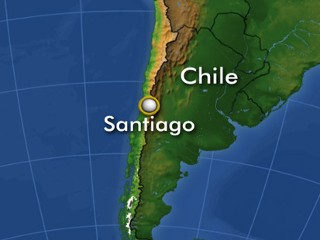Tsunami fears after massive Chile quake
Warning: the quake has
generated a tsunami that may have been destructive along the
Chilean coast
A massive magnitude 8.8 earthquake has struck near
the coast of south-central Chile shaking buildings and causing
blackouts in parts of the capital Santiago, 320 kilometres away.
President Michelle Bachelet said 47 people were killed and that
more deaths were possible, as the US government reported aftershocks
in Chile measuring 6.2, 5.6 and 6.9.
"With the quake of this magnitude, we cannot rule out other
casualties," she said.
Telephone and powerlines were down, making a quick damage
assessment difficult in the early morning darkness.
A tsunami warning was issued for Chile and Peru by the Pacific
Tsunami Warning Centre, and a tsunami watch was issued for Ecuador,
Colombia, Panama, Costa Rica and Antarctica.
Soon after, the centre said the quake had generated a tsunami that
may have been destructive along the Chilean coast near the epicentre.
"Sea level readings indicate a tsunami was generated," the centre
said on its website.
"It may have been destructive along coasts near the earthquake
epicentre and could also be a threat to more distant coasts."
It did not have details on the size of the tsunami.
The USGS has extended a tsunami watch to all of Central America and
French Polynesia.
The USGS said the earthquake struck 90 kilometres north-east of the
city of Concepcion at a depth of 55 kilometres at 3:34am (local time).
Its magnitude was initially reported at 8.3 then 8.5.
People streamed onto the streets of the Chilean capital, more than
320 kilometres north of the epicentre, hugging each other and crying,
a witness reported.
Local television stations said there was damage to buildings in the
historic centre of Santiago and a highway bridge collapsed near the
capital.
Buildings shook and there were blackouts in parts of the city. A
witness reported very strong shaking lasting for 10 to 30 seconds.
CNN Chile president Rolando Santos says, with first light, the
scale of the damage is beginning to emerge in Santiago.
"A lot of collapsed buildings, a lot of people on the streets of
Santiago - to be out of the buildings because of the aftershocks. I
lost count at 25 aftershocks," he said.
"The initial hit was at 3:34 this morning ... one minute I'm in
bed, and the next minute I'm on the floor and everything is coming off
the walls.
"I'm a big man - about 120 kilos - when I left my apartment to come
to the office there was not a single thing on the shelves."
Mr Santos says the shaking was so violent, he was knocked out of
bed and onto the floor.
"It was pretty clear because of the length of the earthquake that
it was going to be a major earthquake. The city almost immediately
went dark ... everything went black," he said.
"And the earthquake lasted ... 45 seconds to almost a minute. I've
been through some quakes in San Francisco and this was one of the
worst."
The international airport in Santiago has been closed and all
flights have been cancelled until further notice, airline officials in
Brazil and Peru have said.
A national emergency official told local radio the government was
evaluating damage in and around Concepcion.
The Philippines' government has warned coastal communities on the
eastern side of the archipelago to prepare for possible tsunami
evacuation.
The Philippine Institute of Volcanology and Seismology said the
quake could generate a destructive tsunami that could hit coastlines
on the western Pacific.
"No evacuation order is in effect but communities along the east
coast of the country are advised to wait for further information and
to prepare for possible evacuation," the government institute said in
an advisory.
"Coastal areas fronting the Pacific Ocean ... should keep watch,"
the advisory said.
The quake struck hours after the southern Japanese island of
Okinawa was hit buy a powerful earthquake.
The 7.0 magnitude quake was measured at a depth of 22 kilometres
and was centred 81 kilometres east south-east of Naha in Okinawa, the
USGS said.
Minor tsunami tidal waves were observed in the southern Japanese
island after the quake but there were no reports of damage.
But Japan's meteorological agency also warned that a tsunami might
be generated from the Chilean quake.
"There is a possibility that tsunami will widely occur in the
Pacific Ocean," an agency official said.
"We are now checking if tsunami may hit Japanese coastal areas."
An earthquake of magnitude 8 or over is classified as a "great"
earthquake that can cause "tremendous damage," according to the USGS
website.
The earthquake that devastated Haiti's capital Port-au-Prince on
January 12 was rated at magnitude 7.0.
According to a 2002 census, Concepcion is one of the largest cities
in Chile with a population of around 670,000. The quake knocked out
power in nearby coastal areas.
The quake struck far from Chile's copper-producing northern region.
Chile is the world's biggest producer of copper, its main export,
producing about 34 per cent of world supply of the metal, which is
used in electronics, cars and refrigerators.
In 1960, Chile was hit by the world's biggest earthquake since
records dating back to 1900, USGS data shows.
The 9.5 magnitude quake devastated the south-central city of
Valdivia, killing 1,655 people and sending a tsunami which battered
Easter Island 3,700 kilometres off Chile's Pacific seaboard and
continued as far as Hawaii, Japan and the Philippines.
- Reuters/AFP
Tags:
disasters-and-accidents,
earthquake,
chile
First posted
3 hours 52
minutes ago






































